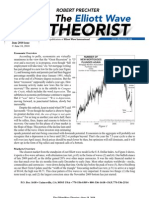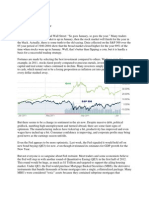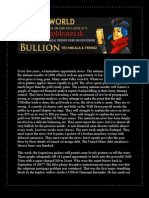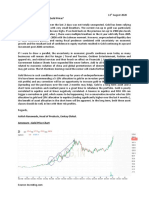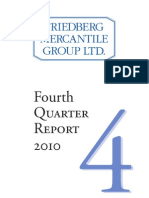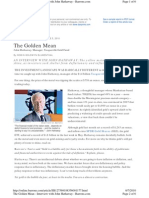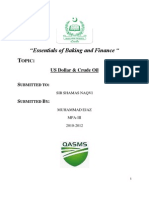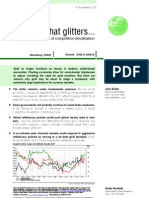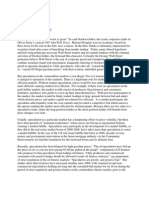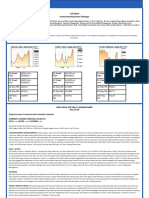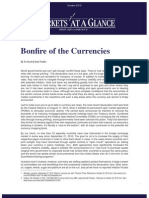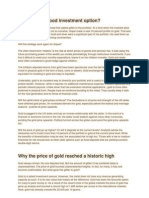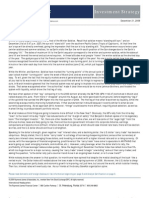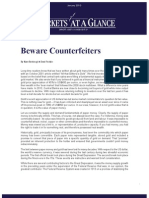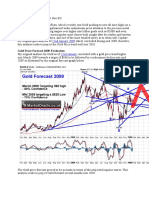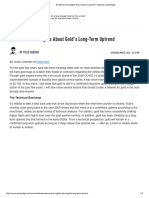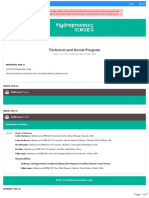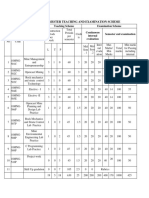Gold Forecast 2010
Gold Forecast 2010
Uploaded by
Mohamed Said Al-QabbaniCopyright:
Available Formats
Gold Forecast 2010
Gold Forecast 2010
Uploaded by
Mohamed Said Al-QabbaniCopyright
Available Formats
Share this document
Did you find this document useful?
Is this content inappropriate?
Copyright:
Available Formats
Gold Forecast 2010
Gold Forecast 2010
Uploaded by
Mohamed Said Al-QabbaniCopyright:
Available Formats
ScotiaMocatta
Precious Metals Forecast 2010
Gold
Executive Summary The Gold rally continues with prices posting fresh all time highs in early October, the rally is expected to continue within an $850-$1,400/oz trading range in 2010. After the turmoil in the financial markets last year a strong rebound has been seen, but with numerous large issues unresolved the rebound seems unsustainable. The fact Gold prices are this high suggests there is still a lot of fear in the markets. If a double dipped recession unfolds, prices could have considerably further to run. The outlook for Gold remains bullish, as it continues to provide a hedge against weakness in fiat currencies and further turmoil in the markets. It should also provide protection against inflation at a later date. Introduction The onset of the financial crisis in the summer of 2008 saw Gold prices sell-off sharply, which to many people was a surprise as given the turmoil in the markets and fear for the banking system, Gold should have been attracting safehaven buying. Indeed it was, but the buying could not absorb all the selling on the back of deleveraging that was happening as the market sold liquid assets to pay margin against their less liquid assets. The sell-off saw prices drop to a low of around $682/oz in October 2008, before the buying once again dominated and investors and traders moved into Gold to protect their capital against the uncertainty swirling around the financial markets. After rebounding to $1,006/oz in February 2009, Gold prices then consolidated in a broad sideways range between $865-$990/oz as the market digested what had happened and what was likely to happen going forward. The fact Gold prices have broken out to the upside of this consolidation pattern is bullish for Gold, but is also a warning that the market feels there is more trouble for the financial markets in the weeks and months ahead. Whether this trouble comes in the form of a double dipped recession, a dollar or bond crisis, or stagflation, inflation, or deflation, remains to be seen.
www.scotiamocatta.com
Precious Metals Forecast 20 1 0_ Gold
October 2 0 09
The present situa tion is one in which the dollar is trending lower again and equities have rallied strongly off their lows. Quantitative easing and government borrowing are providing the means for Western governments to issue stimulus packages and support those industries and institutions that are deemed too big to fail, but the legacy of all this debt and the means to pay it back are likely to become the next problems. As such, there are many cross-currents impacting the global economy that are likely to keep the markets turbulent and dangerous. In this environment we expect Gold to remain highly sought after as the ultimate and time-tested safe-haven. At some stage a broad based sustainable economic recovery is likely to reduce the need for safe-haven investments and that is likely to see money move out of Gold. We think that, before that, the financial environment will deteriorate further and demand for Gold will rise.
The Big Picture Reviewing the testimony of the Worlds central bankers, it appears that the Western banking system was close to collapse in 2008. Governments reacted strongly and without significant constraint and that has halted the meltdown- indeed judging how much equity markets have rebounded, you could even feel they have corrected the problem. However, on closer inspection they have probably only bought some time. They may have prevented a total crisis, but in doing so have saddled countries and electorates with huge debt and budget deficits that are likely to last for years. So once again there seems a myriad of problems that will now need to be overcome before real recovery can begin. Confidence has rebounded, but there is a danger this may prove to be groundless and more a knee-jerk relief reaction that the markets did not implode. Judging by the rise in Gold and other commodity prices and even equity values, it seems that investors want to own something tangible (even if it is just a share in a company) rather than owning fiat money. However, while consumers pay down their debt and unemployment remains high, consumer spending is likely to remain restrained and with this accounting for some 70% of GDP in many developed countries, the prospects of a return to strong growth are low. In addition, the practice in AngloSaxon countries of remortgaging homes to supplement disposable income that helped fuel the consumer boom in the mid- 2000s has been curtailed and this makes any return to high spending less likely. The equity rally started in March 2009 and impressive gains were seen over the summer. Indeed the rally even gained additional momentum on the back of second quarter earnings. However, since much of the improvement was due to cost cutting, there is doubt as to whether the improved earnings picture is sustainable. If not, then another correction in equity prices would be likely and in turn that could spark another risk reduction sell-off. Such a move is likely to initially drag Gold prices down too, but the increased fear that another stock market sell-off would bring, is also likely to see a further movement into Gold as a secondary reaction. In the short-to-medium term the risk of inflation seems subdued and deflation seems a bigger threat as it is latent in many parts of the developed world. Although, for the moment, the popular press might be pointing to inflation as a reason for Golds rise, we would say dollar weakness and concern over fiat currencies and paper assets in general are the more likely drivers. In time inflation, or even stagflation, is likely to become a driving bullish force in the Gold market, but we do not see that being a key driver at present as we expect another down turn in the global economy to dampen price pressures.
Precious Metals Forecast 20 1 0_ Gold
October 2 0 09
One of the risks going forward is that confidence may turn negative again as in such a case deflation could spread as consumers further batten down the hatches. With governments already committed to massive stimulus packages another down turn could see the need for more fiscal boosts and that would run the risk of digging a deeper fiscal hole. Overall the markets current focus seems to be on recovery but we fear there is a high chance of the financial crisis evolving further (perhaps to a dollar - or derivative crisis) and as such think Gold will remain in an up trend, even though there are likely to be significant corrections along the way. How has Gold reacted so far? Since the rally in Gold started in 2001, Gold prices have climbed on the back of a host of issues including: the weaker dollar, increased geopolitical risk, higher oil prices, portfolio diversification, producer dehedging, lower than expected official sales , falling mine production and, until recently, reliable and resilient Asian jewellery demand. The financial crisis has had the effect of reshuffling these factors with the dollar weakness and need for safe- haven investments rising to the top. However, the Gold market has also had to suffer a significant fall off in fabrication demand and a surge in supply in the form of increase scrap sales. Indeed if you look at the balance between supply from mining and scrap and compare it with fabrication demand, Gold would have been in surplus, absent investment demand, to the tune of 750 tonnes in 2008 and an estimated 1,168 tonnes this year and in that case, on pure fundamentals, you would have expected prices to be falling. However, changes in investment demand and official sales have had a hugely positive impact on Gold, while less dehedging has been a negative. Of these influences on the Gold market, it is changes to investment demand that have really driven prices higher. Given the economic environment and the situation in the financial markets, we feel there is good potential for considerably more investment buying and just as any rally can run away on the upside it is possible investment demand could do the same, given the size of the financial market and the Gold markets small size in relationship to it. However, just as any rally can go exponential, at some stage it inevitably corrects - perhaps sharply. With large holdings of Gold in ETFs, futures, bars and coins, the market will rightly be nervous and on the look out for signs of change. However, this should not deter investors from keeping an interest in Gold over the next few years. US creditors The fact that the dollar has been the worlds reserve currency and the currency of trade for so long, means the amount of dollars, and therefore US creditors, in the global market is huge. Seeing the value of the dollar steadily erode must be a nightmare for large US creditors such as China, Japan, South Korea, Russia, the oil producing countries and Sovereign Wealth Funds (SWF). The danger is that they will reduce their exposure, although, in reality their collective holdings are so enormous that if they started to liquidate, the markets would likely collapse making a bad situation a lot worse. So the option to sell seems to have been discounted as unworkable and their second option is to collectively try to underpin the dollar and to ride out the storm. Their third option is to do nothing. As things stand, most Asian central banks have started to build up their reserves again (the exception seems to be Japan), although while China maybe buying US dollar assets on the one hand, it is also diversifying by using dollars to build up strategic stockpiles of commodities. If US creditors were to panic, then a dollar crisis, or bond crisis, would likely follow. However, we think the catastrophic implications of such an outcome will probably prevent such a situation developing, unless a geopolitical showdown between, say, China and the US or Russia and the US, gets out of control.
Precious Metals Forecast 20 1 0_ Gold
October 2 0 09
But the dollar is falling again - will that force creditors hands? The fact the dollar is falling in value is of no surprise as the US has been running a trade deficit for years and has been issuing I.O.Us in the form of Treasury bonds, bills and notes, to pay for the fact that it has consumed more than it has earned. As a result of this, the value of the dollar has been in decline since 2001. For some peculiar reason the onset of the financial crisis in the second half of 2008 saw the dollar rebound, but that was probably as US investors liquidated overseas assets and repatriated them, as well as some overseas investors looking for sanctuary in US Treasuries. The recession has seen the US rein in its trade deficit as consumers have retrenched in a way that should be supportive for the dollar. However, the onset of quantitative easing, whereby the US Federal Reserve prints money to buy Treasuries and enable the US government to boost its borrowing, in order to finance its stimulus spending and bailouts, is bound to devalue the dollar. With other governments, notably the UK, following the same path, and with other countries buying dollars to keep their own currencies weak for competitive reasons, there is a spiral of competitive devaluation underway. The fact that governments can determine the value of their currency and are doing so in this economic climate, provides little confidence for holders of those fiat currencies. So it is not surprising Gold prices are on the rise and the fact Gold prices are rising in other currencies such as euro, sterling and Indian rupees, highlights what an international safe-haven Gold can be. In summary, the big picture outlook is very cloudy. Optimism that the worst is over and that a recovery is underway, is running high. It is therefore reasonable to ask why Gold prices are rising as there is little sign of inflation in the system yet. Furthermore, if the recovery is on the way then why the need of ongoing safe-haven buying? We fear that the rebound is ill- founded and the measures to prevent a melt-down will in turn create other global problems in the financial system, especially for the dollar and also for equities. Consequently, we expect further turmoil in the markets, creating more pain, uncertainty and fear in the process, all of which is likely to boost the appeal of Gold. Factors driving Gold prices The dollar After the dollar weakness seen between 2006 and mid-2008, the dollar started to rebound in July 2008, (see chart opposite) as risk reduction gathered pace and US companies repatriated assets previously held overseas. In addition, the market turned to its traditional safe-havens which included the dollar. However, the dollars rebound ran out of steam as the USs policies to tackle the financial crisis became clear notably to push more money into the failing systems and to finance this by borrowing and by means of quantitative easing. The creation of more debt and the increase in money supply by quantitative easing, have not surprisingly raised concern that the dollar is being devalued. In turn the down trend in the dollar has resumed with the dollar falling against most currencies. Interestingly enough, the better- than-expected economic data that has boosted
Precious Metals Forecast 20 1 0_ Gold
October 2 0 09
the US equity markets has so far failed to underpin the dollar, which is a sign of deteriorating confidence in the dollar. However, once the US makes it clear that it has a policy to soak up the extra money supply, then the combination of this and economic recovery (when it eventually gets going) is likely to see the dollar turn higher. However, if the prospects for growth and loose monetary policy are also seen as being inflationary, then a stronger dollar will not necessarily mean weaker Gold. Inflation fears At present, there is little inflation around; indeed, deflation is more in evidence, although the market does not seem too concerned about deflation as the underlying fear is that all the quantitative easing and global stimulus packages will end up being inflationary. Although in theory governments should be able to tighten monetary policy to out- manoeuvre inflation, there is concern that slow growth and high unemployment rates will make it hard for governments to be proactive and any delay in tightening policy when the time come s, could see inflation take hold. As a result, the threat of inflation down the road is another driving force for Gold, even if it may be premature to be too concerned about it at the moment. De-hedging At the start of the bull market for Gold, which roughly coincided with the start of de- hedging, the total hedge book stood at 3,107 tonnes (99.9Moz). Eight years later it has already fallen to 458 tonnes (14.7Moz). As the hedge book shrinks the level of de-hedging has not surprisingly slowed, but is still running at around 125 tonnes a year and is likely to continue to provide support next year. However, after years of providing support de-hedging will become less of an issue in the years ahead and then the combination of high Gold prices with improving prospects for economic recovery and therefore less need for safe-havens, could well start to see producers look at re-establishing hedges. Although the current wishes of shareholders of mining companies is for no, or limited, hedging, that might change if the bullish outlook for Gold changes as we move into a new economic era. However, we would expect the next hedging wave to be done via put options and not outright forward/futures sales. For the moment the mood amongst producers is, in the majority, still bullish for the Gold price in the period ahead. Central Bank Official Sales For the fourth year running sales made under the Central Bank Gold Agreement (CBGA) have failed to reach the maximum amount of 500 tonne s allowed by the agreement. In the CBGA year that ended in September 2006, sales were 104 tonnes short of the 500 tonne allowance; in 2006/07 sales fell short by around 24 tonnes; in the 2007/08 period sales were 143 tonnes short of the limit and in the year to 26th September 2009, sales totalled 160 tonne,340 tonnes short of the limit. So for CBGA-2 as a whole , sales of between 1,880 and 1,900 tonnes were some 75% of the permitted 2,500 tonnes. On 7th August, 2009, a ne w fiveyear CBGA was announced by its 19 signatory members, but the annual quota was cut to 400 tonnes, even though the IMF has said it plans to sell its 403.3 tonnes of Gold during CBGA-3. However, with China and Russia looking to increase Gold reserves, net supply from official sales may be limited in the years ahead. Central Bank diversification The global financial crisis has exposed how vulnerable central banks are to the dollar and US Treasuries. As a result, a number of large sovereign holders of US dollars and Treasuries have started to diversify their holding. China surprised the market in April 2009, when it announced its Gold reserves had increased 76% to 1,054 tonnes since 2003, when it held 600 tonnes. However, this higher holding still represents only 1.9% of total reserves. With China holding over $2 trillion of currency reserves and with some 70% of this in dollar denominated assets, China is heavily exposed to the value of the US dollar and not
Precious Metals Forecast 20 1 0_ Gold
October 2 0 09
surprisingly is keen to diversify. There is talk that China might buy some of the Gold that the IMF is selling, but China is also likely to prefer to continue buying Gold from its domestic producers. In 2007, China surpassed South Africa as the worlds largest Gold producer with production reaching 282 tonnes in 2008 and rising 13.5% in the first half of 2009. In addition, Russia has continued to build up its Gold reserves. It bought 69 tonnes in 2008 and in the January to August period this year, it has bought a further 62 tonnes. As of September, it held some 568 tonnes, or 4.3% of its reserves. Back in November 2005 it stated that it would be appropriate to hold 10% of its reserves in Gold, which would mean increasing Gold holdings to 1,320 tonnes. Holding 10% of reserves in Gold is about the average that all countries hold although, however, the Euro area holds an average of 59.7%, the US holds 77.4%, while Japan holds just 2.3% and Korea holds just 0.2%. Oil Oil and Gold prices have been positively correlated for most of the bull run, indeed the turn down in oil prices in mid-July lasts year coincided with weaker Gold prices too. It is interesting that Gold prices have held up better than oil prices and this serves to highlight the poor current economic conditions. Indeed, although optimism is running high about economic recovery, judging by industrial commodity and equity prices, the fact oil is still well below the highs and Gold is near record highs, does raise questions as to how strong real recovery prospects are. When oil does start to run higher in anticipation of economic recovery then the rising oil price is also likely to be seen as inflationary which, in turn, is likely to be supportive for Gold prices too. Jewellery demand High Gold prices and the impact of the global economic slo wdown over the past twelve months has led to a significant drop in Gold demand from the jewellery and industrial sectors. In the second quarter 2009, World demand for Gold fell 9% year on year, with jewellery demand off 22%. Industrial demand, which accounts for 13% of Golds use, fell 21%. The biggest impact has been seen in India where according to the World Gold Council (WGC), Gold imports in the first half of the year fell 55% to 126 tonnes. Turkeys imports have also been very low with just 32.9 tonnes imported in the January to September period compared to 164.6 tonnes in the same period in 2008. Demand from jewellery manufacturers continues to be price elastic, but in addition to price, the sector is suffering the fall out from recession where cons umers have cut back on luxury purchases. Gold jewellery demand peaked in 2005 at 2,707 tonnes, it fell to 2,288 tonnes in 2006, rebounded in 2007 to 2,404 tonnes, fell to 2,159 tonnes last year and is likely to be around 2,000 tonnes this year. However, the steady fall in demand combined with the large amount of jewellery scrapping that has taken place in recent years, is likely to have created considerable pent up demand across the jewellery spectrum from jewellery fabricators to jewellery retailers to jewellery owners. Once global recovery is underway we would expect a strong rebound in jewellery demand with China leading the way, followed by Asia. Even during the recent economic slowdown, Chinese demand for Gold jewellery managed to rise 6% in Q209 only just down from the 8% rise in 2008.
Precious Metals Forecast 20 1 0_ Gold
October 2 0 09
Investment demand continues to grow The financial crisis has put Gold firmly back in the spotlight as investors have wanted to protect their wealth as well as speculate on Golds price rise. At the height of the banking crisis there was fear about holding money in banks and sales of Gold bars and coins shot higher, but even though this fear has subsided (as has demand for coins and small bars), there is more than enough concern about the state of the financial markets, fiat currencies and inflation, to see investors continue to want to diversify their investments. The interest in Gold Exchange Traded Funds (ETF) has continued to build (see chart opposite) and the fact this has happened despite soaring equities is noteworthy and suggests these are long term investments aimed at diversifying portfolios. Interestingly there was a period over the summer that did see a pick-up in redemptions and this seems to have been as a result of money shifting from safe- havens to riskier equity investments. However the trend in the level of holdings is now rising again, which suggests either money is rotating back into the safety of Gold, or else funds continue to invest new money into Gold, either of which is a healthy sign of ongo ing confidence in bullion. At some stage, once recovery is underway and the threat of inflation is under control, further redemptions are likely and with around 1,700 tonnes of Gold held in ETFs, the market may well correct significantly. However, this is unlikely to be an issue in 2010 because there is still the risk of a double-dipped recession, dollar devaluation and eventual inflation. In addition, after the near collapse of the financial system in 2008 and early 2009, the practice of keeping investment portfolios diversified is likely to remain in place and as the amount of money in the investment pool grows and the practice spreads geographically, the flow of money into Gold is likely to remain strong. The Futures market - In February 2008, the net long fund position reached a high of 212,259 contracts (660mt). During the broad based risk reduction sell-off in the second half of that year the position fell to 63,959 contracts (199mt), before recovering this year and rising to a new record high of 236,749 contracts. During these gyrations in the net fund long position it has not surprisingly been changes in the gross long position that have seen the aggressive movements, with the short position fluctuating less. For example from the February 2008 position high to the November 2008 low, the longs cut their position by 53%, while the shorts increased theirs by 32% and the recent rise in the net long position has seen the gross longs increase their holdings by 137%, while the short position has dropped 62%. The gross long position was at a high of some 827 tonnes in late September which is worrying some market commentators, but with the peak in
Precious Metals Forecast 20 1 0_ Gold
October 2 0 09
the net long position in 2008 some 20% above the peak in 2005, a further 20% gain could be envisaged and could see the net long position climb another 20,000 contracts or so. Given that quantitative easing has raised the stakes in competitive currency devaluation and inflation, we see that the market may well be able to sustain an even larger fund long position. Supply After seven years of higher Gold prices the supply response is beginning to be seen with output on the increase again, ending a down trend in production that has lasted for more than a decade. In 2008, mine production was 2,416 tonnes, the lowest for twelve years, however in the first half of 2009, mine output increased 7% according to GFMS. In recent years demand for all the factors of production needed by miners have been particularly strong and shortages have disrupted mine output , expansions and new mine development. These factors have affected Gold producers just as much as base metal producers. Indeed even over the past year with the pull back in base metal production that has alleviated the equipment and manpower tightness, Gold producers have still been suffering from credit issues and financing constraints and the bulk of the increase in production recently has come from China and Russia, where financing is not dependent on the Western banking system. That said, better operating conditions and scheduled production expansions in the West have seen some pick- up in output and, as financial constraints ease and as profit margins rise, output is likely to increase as producers capitalise on record high Gold prices. Overall with average cost of production at around $650$700/oz, current margins are likely to encourage a faster-than- forecast rebound in global mine production. China remains No.1 producer China became the worlds largest Gold producer in 2007 and held that position in 2008, and with output up 13% in the first seven months of 2009, it seems to be extending its lead. South Africa continues to see output fall, with H109 production falling and output in July off 7.6% year on year. Australias mine production is on the increase again as is Russian production that rose 21.7% in H109 to 89.2 tonnes. In Peru and Indonesia output also increased. 2009s production is expected to be around 2,488 tonnes, up around 3% from 2008s level of 2,416 tonnes and this is expected to climb next year by around 2% to 2,537 tonnes. The extra 50 tonnes will come from the numerous expansions and new mines scheduled to come on stream predominantly in Australia and Canada. However, even if production rises to this level it will still leave mine output below the level reached in 1998. Scrap Scrap supply has become more volatile in recent years and as a result is having more influence on the supply / demand balance and on prices. In 2008, annual Gold scrap supply amounted to around 1,220 tonnes, and in H109 alone it had reached 900tonnes, with some 550 tonnes coming on to the market in Q109 and 350 tonnes in Q209. Generally after periods of high scrap flows, the following period is that much quieter. Indeed the rise in advertisements along the High Street and in local newspapers encouraging people to sell old jewellery is bound to have sucked a lot of scrap out of the woodwork by now, leaving less there for scrapping in the future. In 2009 as a whole, it is estimated that scrap supply could reach 1,300 tonne s. Therefore over the past two years roughly 2,500 tonnes of scrap will have been returned to the market, equivalent to around one years worth of mine production. This destocking bodes well for the supply / demand balance going forward as it suggests on the one hand there will be less scrap supply in 2010 and, secondly, having got rid of old jewellery, there may well be pent up demand for new jewellery.
Precious Metals Forecast 20 1 0_ Gold
October 2 0 09
As such, although mine output is expected to pick-up next year, we feel it will be more than offset by a drop in scrap supply. Indeed if mine output rises 50 tonnes in 2010 and, say, scrap supply falls to its ten year average of 960 tonnes, the n 2010 could see net scrap and mine supply 290 tonnes lower than this year. Technical Outlook After a long period of consolidation after the run up to $1,006/oz in February 2009, prices have broken higher out of the triangle and are in the process of setting fresh all time highs. At present prices do not look too extended and the stochastic indicators are looking strong too. The strong rally in August 2007, went from $640/oz to $1,032.50/oz, a move of close to $400/oz, so with this latest bullrun starting around $680/oz a similar run would take prices towards $1,100/oz. As far as pull backs are concerned, the uptrend line at $970/oz should provide support as should the $1,000/oz area. A move below the uptrend line would then suggest a possible pull back to around the $900/oz area, where the 60 week moving average lies. The stochastics did recently cross lower but failed to move down too far and have now crossed higher. A similar situation was seen in January 2009 and after the stochastics crossed higher again price went on to rise $200/oz. With prices breaking into new high ground, we would target $1,250/oz as the ne xt major upside target. (After the move above $850/oz prices climbed 21.5%, so a similar percentage move from $1,032.50/oz is $1,254/oz). Overall we expect Gold to extend its gains, but once the next peak has been established another long period of consolidation is likely to follow as the market adjusts to the price rise. Forecast & Conclusion Gold is going through a very interesting time, but there are a multitude of factors influencing the price some of which are quite contradictory such as the presence of deflation and the fear of inflation. We also have an uneasy feeling that after the near catastrophic events seen over the past twelve months, the sharp recovery seen since March seems too good to be true and for that reason it probably is. Indeed given the massive governments stimulus packages and bailouts mainly paid for with borrowed and printed money, there is considerable uncertainty as to what lies ahead. The global imbalance between those countries that have massive dollar debt and those with huge dollar reserves, is also coming to a head as the US seems set on a path to devalue the dollar by means of quantitative easing. In addition, the weak dollar is prompting competitive currency devaluation and with numerous former hard currencies trying to lose value, it is not surprising that faith in fiat currencies is waning and those with money are looking to diversify into assets with intrinsic value, of which Gold and other commodities are top of the list. Indeed this might well be what is driving base metals higher, even though demand is weak and stockpiles are mounting. The fact US dollar creditors are talking about the need for another global reserve currency shows that they are losing faith in the dollar.
Precious Metals Forecast 20 1 0_ Gold
October 2 0 09
Overall, given the parlous condition of the worlds financial markets in recent years, it is doubtful that the short-sharp asset-bubble deflation seen in the second half of 2008 and first quarter of 2009, resolved the matter completely. There are still many unsolved problems and imbalances that need to be settled and as there does not seem to be any easy way to fix them, the financial system and the heavily indebted countries are likely to experience more hardship in the future. The Western financial system has always had been founded on confidence, and in 2008 this confidence was shattered. The rebound across markets this year has restored some hope but with many of the underlying issues unresolved, this new dawn may prove false. If events take another turn for the worse, the fear seen in 2008 is likely to be renewed and another flight to safety could well keep the bull market in Gold go ing for a considerable while longer and a take prices considerably higher. It seems likely that there is still a big window of opportunity for Go ld to shine in the months ahead. At some stage, the problems facing the global economy, especially those in the West, will be solved and a return to normality will unfold. When that process begins, safe- haven assets are likely to be sold. However until such time, Gold is likely to remain highly soughtafter as a store of wealth and we would not be surprised to see Gold prices rise to, perhaps significantly, new highs. There are likely to be periods of widespread risk reduction that carry Gold prices lower too, but each dip is expected to attract strong scale down buying from investors and fabricators. Overall, we would expect the bulk of trading between now and the end of 2010 to be within the $850/oz to $1,400/oz range.
10
Precious Metals Forecast 20 1 0_ Gold
October 2 0 09
SCOTIAMOCATTA is a global leader in metals trading, brokerage and finance. As part of Scotia Capital and a member of the Scotiabank Group, clients can access a full range of financial products and services. To obtain additional information on ScotiaMocatta products and services, call one of the offices listed below.
CANADA Toronto Scotia Plaza 40 King Street West Box 4085, Station A Scotia Plaza Toronto, Ontario M5W 2X6
Jose Maria Tapia
jose_tapia@scotiacapital.com
Shankara Subramanian
shankara.subramanian@scotiabank.com
Tel: 52 55 9179 5142 Fax: 52 55 5325 3527 INDIA Mumbai 11-13 Maker Chambers VI 1st Floor 220 Nariman Point Mumbai 400021
Tel: 91-422-2301-595 Fax: 91-422-2301-596 HONG KONG SAR 25th Floor, United Centre 95 Queensway Hong Kong
Andy Montano
andy_montano@scotiacapital.com
Tel: 1-416-866-7835 Fax: 1-416-866-6897 UNITED KINGDOM London Scotia House 33 Finsbury Square London EC2A 1BB
Alice Lam
alice_lam@scotiacapital.com
Rajan Venkatesh
rajan_venkatesh@scotiacapital.com
Tel: 852-2861-4788 Fax: 852-2573-7869 SINGAPORE 1 Raffles Quay #20-01, North Tower One Raffles Quay Singapore, 048583
Tel: 91-22-2288-0994 (Direct) Fax: 91-22-2288-1078 New Delhi Upper Ground Floor Dr. Gopal Das Bhavan 28 Barakhamba Road New Delhi 110001
David Wilkinson
david_wilkinson@scotiacapital.com
Tel: 44-20-7826-5931 Fax: 44-20-7826-5948 UNITED STATES New York One Liberty Plaza 165 Broadway New York, N.Y. 10006
Swee Kiang Teo
Sweekiang_teo@scotiacapital.com
Prem Nath
Prem.nath@scotiabank.com
Tel: 65-6536-3683 Fax: 65-6534-7825 UNITED ARAB EMIRATES Dubai 302, 3rd Floor Precinct Building 03 Dubai International Financial centre Dubai UAE
Tel: 91-11-5535-2420 Fax: 91-11-2335-9342 Bangalore 25/2 S.N. Towers M.G. Road Bangalore 560001
Tim Dinneny
tim_dinneny@scotiacapital.com
Tel: 1-212-225-6200 Fax: 1-212-225-6248 MEXICO Mexico City Blvd. M. Avila Camacho #1, Piso 11 Col. Chapultepec Polanco Colonia Polanco 11560 Mexico
Mahendran Krishnamurthy
mahendran.Krishnamurthy@scotiabank.com
Tel: 91-80-2532-5325 Fax: 91-80-2558-1435 Coimbatore Classic Towers 1547 Trichy Road Coimbatore 641018
Pramod Mohan
Pramod_mohan@scotiacapital.com
Tel: 97 14 3711 777 Fax: 97 14 228 9090
11
Precious Metals Forecast 20 1 0_ Gold
October 2 0 09
This report has been prepared on behalf of ScotiaMocatta and is not for the use of private individuals. The ScotiaMocatta trademark represents the precious metals business of The Bank of Nova Scotia. The Bank of Nova Scotia, a Canadian chartered bank, is incorporated in Canada with limited liability. Opinions, estimates and projections contained herein are subject to change without notice. The information and opinions contained herein have been compiled or arrived at from sources believed reliable but no representation or warranty, express or implied, is made as to their accuracy or completeness. Neither the Bank of Nova Scotia, its affiliates, employees or agents accepts any liability whatsoever for any loss arising from the use of this report or its contents. The Bank of Nova Scotia, its affiliates, employees or agents may hold a position in the products contained herein. This report is not a direct offer financial promotion, and is not to be construed as, an offer to sell or solicitation of an offer to buy any products whatsoever. This market commentary is regarded as a marketing communication. It has not been prepared in accordance with legal requirements designed to promote the independence of investment research and is not subject to any prohibition on dealing ahead of the dissemination of investment research. The Bank of Nova Scotia is authorised and regulated by The Financial Services Authority.
12
You might also like
- Cut and Fill MethodDocument26 pagesCut and Fill MethodANSHUL YADAVNo ratings yet
- Elliot Wave Theorist June 10Document10 pagesElliot Wave Theorist June 10Mk S Kumar50% (2)
- ComPro SWI Energi KalimantanDocument16 pagesComPro SWI Energi KalimantanHAPPY STORYNo ratings yet
- Scotia Mocatta - Gold 2012 Forecast 11-01-11Document13 pagesScotia Mocatta - Gold 2012 Forecast 11-01-11Bullwinkle2No ratings yet
- Precious Metals Forecast 2007: January 2007Document17 pagesPrecious Metals Forecast 2007: January 2007gairatNo ratings yet
- 8-22-11 Breakout in Precious MetalsDocument4 pages8-22-11 Breakout in Precious MetalsThe Gold SpeculatorNo ratings yet
- Investor'S Guide: by Jeff Clark, Editor of Big GoldDocument12 pagesInvestor'S Guide: by Jeff Clark, Editor of Big GoldVishnu VardhanNo ratings yet
- 5 Reasons Why Gold Will RiseDocument1 page5 Reasons Why Gold Will RisejogalbhushanNo ratings yet
- 1-23-12 More QE On The WayDocument3 pages1-23-12 More QE On The WayThe Gold SpeculatorNo ratings yet
- Investor'S Guide: by Jeff Clark, Editor of Big GoldDocument12 pagesInvestor'S Guide: by Jeff Clark, Editor of Big GoldaldilnojinjaloNo ratings yet
- Gold Public Monthly Commentary 2011 05Document3 pagesGold Public Monthly Commentary 2011 05Sara CostaNo ratings yet
- Gold and Silver Opportunity July 2011Document8 pagesGold and Silver Opportunity July 2011chiefNo ratings yet
- Gold Industry Report Featuring Goliath May 4 2021Document10 pagesGold Industry Report Featuring Goliath May 4 2021Chester Yukon GoldNo ratings yet
- Worried About The Fall in Gold Price?: Ashish Ranawade, Head of Products, Emkay Global. Annexure: Gold Price ChartDocument1 pageWorried About The Fall in Gold Price?: Ashish Ranawade, Head of Products, Emkay Global. Annexure: Gold Price ChartspeedenquiryNo ratings yet
- 8-15-11 Steady As She GoesDocument3 pages8-15-11 Steady As She GoesThe Gold SpeculatorNo ratings yet
- Gold TruthDocument3 pagesGold TruthKamal GuptaNo ratings yet
- Fourth Q Uarter R Eport 2010Document16 pagesFourth Q Uarter R Eport 2010richardck61No ratings yet
- Factors Affecting The Gold PriceDocument8 pagesFactors Affecting The Gold PriceAjinkya AgrawalNo ratings yet
- 2009 Winter Warning Volume 10 Issue 1Document6 pages2009 Winter Warning Volume 10 Issue 1stevens106No ratings yet
- The Golden Mean: NterviewDocument6 pagesThe Golden Mean: NterviewvagierayNo ratings yet
- Gold N Silver Price Hikes!!Document27 pagesGold N Silver Price Hikes!!apurva2205No ratings yet
- Week in Review: Gold Fundamentals Are Intact. Current Prices Are A Buying Opportunity!Document26 pagesWeek in Review: Gold Fundamentals Are Intact. Current Prices Are A Buying Opportunity!Paolo GerosaNo ratings yet
- Gold Vs Gold StocksDocument4 pagesGold Vs Gold StocksZerohedgeNo ratings yet
- "Essentials of Baking and Finance ": US Dollar & Crude OilDocument9 pages"Essentials of Baking and Finance ": US Dollar & Crude Oilejaz_balti_1No ratings yet
- All That Glitters... The Financial Market Implications of Competitive DevaluationDocument12 pagesAll That Glitters... The Financial Market Implications of Competitive DevaluationJohn ButlerNo ratings yet
- Second Greatest Opportunity To Buy Gold-Empire Club 10.01.14Document4 pagesSecond Greatest Opportunity To Buy Gold-Empire Club 10.01.14richardck61No ratings yet
- 6-26-12 Greed Is Good.Document4 pages6-26-12 Greed Is Good.The Gold SpeculatorNo ratings yet
- In Gold We Trust 2016 Short VersionDocument21 pagesIn Gold We Trust 2016 Short VersionTFMetalsNo ratings yet
- MS 2012 Outlook: Precious MetalsDocument6 pagesMS 2012 Outlook: Precious Metalsz2009z2009No ratings yet
- Will Gold Continue To Shine?: MarketDocument6 pagesWill Gold Continue To Shine?: MarketdpbasicNo ratings yet
- Daily Metals Newsletter - 01-27-16Document1 pageDaily Metals Newsletter - 01-27-16Jaeson Rian ParsonsNo ratings yet
- Thoughts On Gold - What An Awful Week Gevers Wealth Management, LLC April 2013Document13 pagesThoughts On Gold - What An Awful Week Gevers Wealth Management, LLC April 2013Gevers Wealth Management, LLCNo ratings yet
- Bonfire of The CurrenciesDocument5 pagesBonfire of The CurrenciesNolan AndersonNo ratings yet
- 11/11/14 Global-Macro Trading SimulationDocument20 pages11/11/14 Global-Macro Trading SimulationPaul KimNo ratings yet
- (Kitco News) - Like A Prizefighter Who Has Taken A Few Upper Cut BlowsDocument3 pages(Kitco News) - Like A Prizefighter Who Has Taken A Few Upper Cut BlowsJohnson LiuNo ratings yet
- Asset Allocation: Fall 2010: Olume CtoberDocument30 pagesAsset Allocation: Fall 2010: Olume Ctoberrichardck50No ratings yet
- What Caused The Sharp Fall in Gold PricesDocument2 pagesWhat Caused The Sharp Fall in Gold Pricesbranc1No ratings yet
- March 2018 Investment Letter - Corona Associates Capital Management LLCDocument5 pagesMarch 2018 Investment Letter - Corona Associates Capital Management LLCJulian ScurciNo ratings yet
- A Golden MulliganDocument14 pagesA Golden MulliganNick WeeksNo ratings yet
- Is Gold Still A Good Investment OptionDocument3 pagesIs Gold Still A Good Investment OptionSwati ShahNo ratings yet
- GOLD - The Simple Facts: ViewpointDocument5 pagesGOLD - The Simple Facts: ViewpointjohnreidenbaughNo ratings yet
- Investment Strategy: Turning Point?Document5 pagesInvestment Strategy: Turning Point?marketfolly.comNo ratings yet
- Gold's Irrational Price Movement: Understanding GoldDocument7 pagesGold's Irrational Price Movement: Understanding GoldNamrata KanodiaNo ratings yet
- Week Summary: Macro StrategyDocument10 pagesWeek Summary: Macro StrategyNoel AndreottiNo ratings yet
- 7-18-11 Safe Haven TradeDocument3 pages7-18-11 Safe Haven TradeThe Gold SpeculatorNo ratings yet
- RGSF Product Note Oct 2012 PDFDocument10 pagesRGSF Product Note Oct 2012 PDFinfosipriNo ratings yet
- Reasons To Own GoldDocument4 pagesReasons To Own Goldasset68No ratings yet
- Money Supply Paper Jan10Document9 pagesMoney Supply Paper Jan10Frode HaukenesNo ratings yet
- Gold and Bitcoin 2018Document5 pagesGold and Bitcoin 2018Ankur ShardaNo ratings yet
- 2Q 2016 Tocqueville Gold Strategy Letter FinalDocument15 pages2Q 2016 Tocqueville Gold Strategy Letter Finalredcorolla95573No ratings yet
- 11/13/14 Global-Macro Trading SimulationDocument17 pages11/13/14 Global-Macro Trading SimulationPaul KimNo ratings yet
- Investmentu Gold's SurgeDocument5 pagesInvestmentu Gold's Surgehttp://besthedgefund.blogspot.comNo ratings yet
- Towards HyperinflationDocument14 pagesTowards Hyperinflationpaganrongs100% (1)
- Beware Counterfeiters: By: Kevin Bambrough & David FranklinDocument4 pagesBeware Counterfeiters: By: Kevin Bambrough & David FranklinZerohedgeNo ratings yet
- Gold Market Forecast 2010Document8 pagesGold Market Forecast 2010Anonymous fE2l3DzlNo ratings yet
- 11/14/14 Global-Macro Trading SimulationDocument17 pages11/14/14 Global-Macro Trading SimulationPaul KimNo ratings yet
- Gold Market Us PDFDocument60 pagesGold Market Us PDFMohan RajNo ratings yet
- Evidence and Insights About Gold's Long-Term UptrendDocument9 pagesEvidence and Insights About Gold's Long-Term UptrendDimi TheProNo ratings yet
- Gold InvestmentDocument4 pagesGold InvestmentvinitclairNo ratings yet
- InvestmentDocument9 pagesInvestmentInzamam ul haqNo ratings yet
- The Changing Role of Gold Within the Global Financial ArchictectureFrom EverandThe Changing Role of Gold Within the Global Financial ArchictectureNo ratings yet
- The Global Crash of 2015 and What You Can Do to Protect YourselfFrom EverandThe Global Crash of 2015 and What You Can Do to Protect YourselfNo ratings yet
- Suresh Khatri-Pimpalvihir Stone QuarryDocument40 pagesSuresh Khatri-Pimpalvihir Stone QuarryVIKAS PANDEYNo ratings yet
- Luwu Threat Assessment Risk Analysis ReportDocument147 pagesLuwu Threat Assessment Risk Analysis ReportOtto HutahayanNo ratings yet
- Curso Strategic Mine Planning Optimization InglesDocument3 pagesCurso Strategic Mine Planning Optimization InglesluisparedesNo ratings yet
- ProgramaDigital PDFDocument7 pagesProgramaDigital PDF1394203031No ratings yet
- Calculations On Loading & HaulageDocument24 pagesCalculations On Loading & HaulageSarah Mae Ajon95% (22)
- Summary Tailings DesignDocument1 pageSummary Tailings DesignChamel “cham” RuperezNo ratings yet
- 10 1 1 90 7867 PDFDocument11 pages10 1 1 90 7867 PDFAlejandro NavarroNo ratings yet
- Lectura 07 Modern Continuous Smelting and Converting by Bath Smelting TechnologyDocument23 pagesLectura 07 Modern Continuous Smelting and Converting by Bath Smelting Technologycarorodriguezlorca12100% (1)
- Biki Mukharjee CV Geologist Profile-1Document2 pagesBiki Mukharjee CV Geologist Profile-1Vijay JoshiNo ratings yet
- Deswik White Paper Pseudoflow ExplainedDocument10 pagesDeswik White Paper Pseudoflow ExplainedKamara100% (1)
- Basic BlastingDocument79 pagesBasic BlastingSunilNo ratings yet
- Mining MarketsDocument32 pagesMining Marketsmackenziebromstad1265No ratings yet
- C-16 - Time Table-2022Document23 pagesC-16 - Time Table-2022partha sarathi guggiriNo ratings yet
- The Philippines Under Japan: Occupation Policy and ReactionDocument3 pagesThe Philippines Under Japan: Occupation Policy and ReactionFrederick Grapiza DominnoNo ratings yet
- Mic VerticalDocument139 pagesMic VerticalRavi KrishnanNo ratings yet
- Barabady - Kumar - 08 Reliability Analysis of Mining EquipmentDocument7 pagesBarabady - Kumar - 08 Reliability Analysis of Mining EquipmentNivardo Celi Rivera ToralvaNo ratings yet
- DMNG C18 5th Sem SyllabusDocument141 pagesDMNG C18 5th Sem SyllabusSai teja ThatikondaNo ratings yet
- TienkoDocument2 pagesTienkoFreNo ratings yet
- Binder, Eando - After An AgeDocument92 pagesBinder, Eando - After An AgePaulo EtcNo ratings yet
- Ore Dilution E-BookDocument24 pagesOre Dilution E-BookouedraogoNo ratings yet
- Madhucon BrochureDocument19 pagesMadhucon BrochureZoeb MerchantNo ratings yet
- Pratama Et Al - Secondary Stoping With Total 10 M Width Span On Weak Rock Mass at Pongkor Gold Mining Business Unit IndonesiaDocument10 pagesPratama Et Al - Secondary Stoping With Total 10 M Width Span On Weak Rock Mass at Pongkor Gold Mining Business Unit Indonesiajeha kunramadiNo ratings yet
- Ocman PDFDocument298 pagesOcman PDFHugo BanegasNo ratings yet
- Final Score Competition Ismc 9 / Seasmc 1Document3 pagesFinal Score Competition Ismc 9 / Seasmc 1Michael Oktavianus Dwi PutraNo ratings yet
- Business Codes 2Document29 pagesBusiness Codes 2whitneyNo ratings yet
- Continous Miner and Road HeaderDocument22 pagesContinous Miner and Road HeaderAhsan Ali100% (1)
- G10446 RG Viewpoints Determining Technical Feasibility Commercial Viability October 2017 PDFDocument7 pagesG10446 RG Viewpoints Determining Technical Feasibility Commercial Viability October 2017 PDFJulian Adam PagalNo ratings yet
- Iluka Technical Brochure 07 12 09Document32 pagesIluka Technical Brochure 07 12 09Christopher LuNo ratings yet

